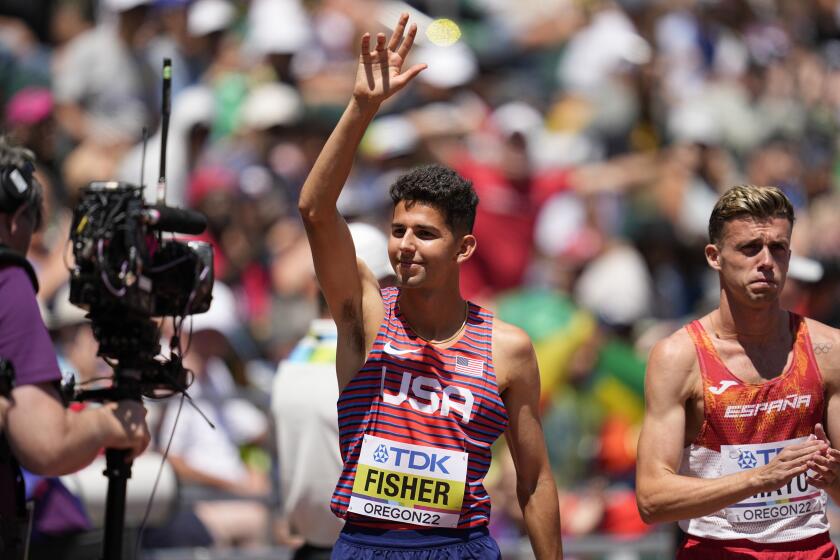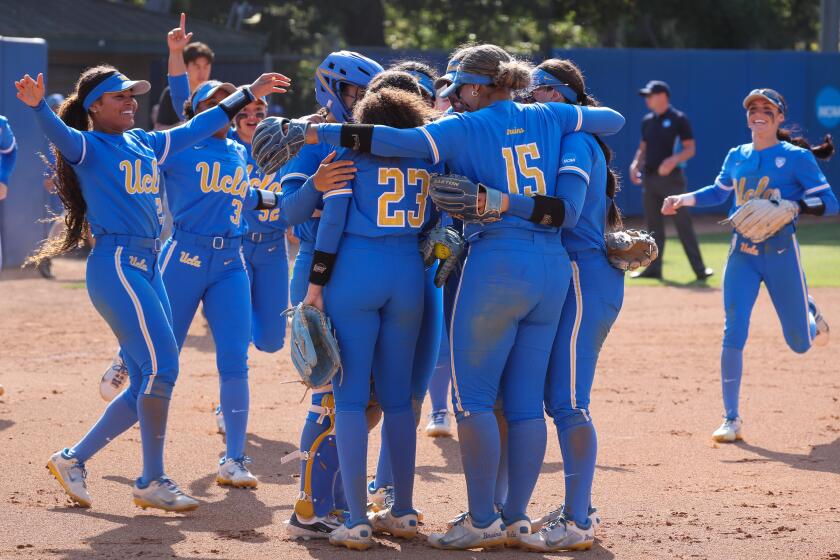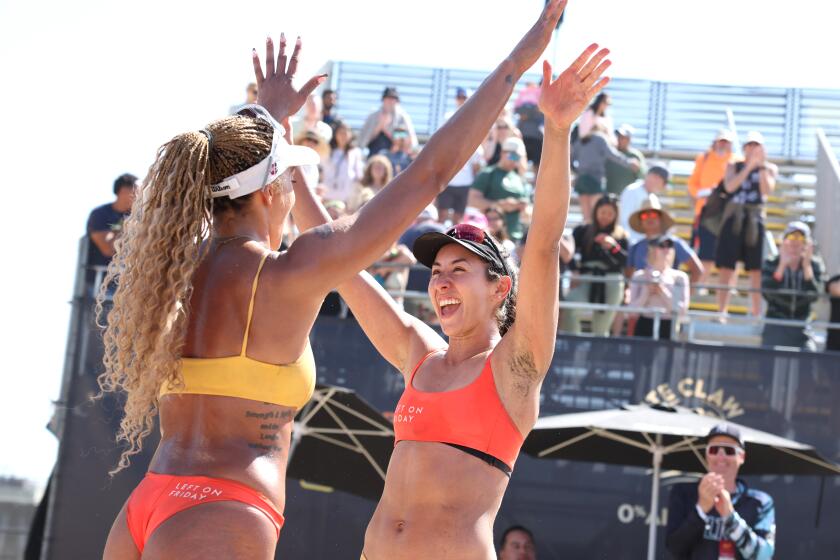Two-Time NCAA Champion Has Double the Fun : Colleges: Stanford’s McLaren would rather participate in volleyball and swimming than excel in one.
She returned home after a freshman year at Stanford that included not one, but two, national championships, a feat no Cardinal woman and few Cardinal men had accomplished.
Most athletes could squeeze plenty of mileage out of that topic of conversation, but Maureen McLaren would rather talk surf.
The 1992 Newport Harbor graduate could easily have a swollen head after participating on Stanford’s NCAA championship volleyball and swimming teams, but she’s quick to change the subject.
“People ask me, but I don’t like to talk about it,” McLaren said. “I’d rather talk about the waves at the beach.”
McLaren isn’t about to break an arm patting herself on the back. Though she played in 27 of Stanford’s 33 matches, she wasn’t used in the championship against UCLA.
At least she sat the bench for that final. An injury to a key swimmer enabled McLaren to travel to most of Stanford’s away swim meets, but she wasn’t fast enough to qualify for the nationals in Minnesota.
“I’m kicking myself. I should have bought a plane ticket and gone anyway,” she said with a sigh.
But her real source of discontent centers more on what she didn’t do when she was there than when she wasn’t.
Unlike high school, where McLaren was a driving force on the Sailors’ volleyball, swimming and basketball teams, she felt her contributions were infrequent and insufficient.
“I can’t believe I was on two teams that won national championships,” McLaren said as she stretched her 6-foot-1 frame on the lawn outside her brother’s home. “I would like to do it again, but contribute more (statistic) wise.”
Toward that goal, McLaren is essentially repeating the summer of ‘92, when she worked out with Newport Harbor volleyball Coach Dan Glenn and trained in the weight room. This summer, she has added a morning swim session to her regimen.
Still, a ray of guilt tweaks McLaren every time she hears from a teammate who’s in some camp, working out with some national team or appearing in some prestigious competition.
“I just got off the phone with someone from Stanford who’s on the National ‘B’ (volleyball) team,” McLaren said. “Other girls are at the World University Games or training at some high level. I just want to make sure I’m on the same page when I go back. I don’t want to hurt the team.”
McLaren’s .485 hitting percentage certainly didn’t last season. It was the team’s best, although she didn’t have many chances (35 in 66 attempts).
And she didn’t make any waves with her swimming times. In fact, they didn’t even improve from her senior year in high school.
“I had a horrible year,” was her description of her pool performances.
It would have been difficult to swim much faster. McLaren, who is on a full volleyball scholarship, joined the swim team almost by accident. A volleyball teammate was a roommate of backstroke specialist Lea Loveless, who encouraged McLaren to try both sports.
But McLaren hadn’t touched the water in eight months, when she took second in the 100-yard backstroke at the Division I Southern Section meet. She also had no club experience, which is akin to a golfer with a 12 handicap deciding to join the PGA Tour.
In today’s age of specialization, it’s unusual to find a two-sport athlete who can excel at a Division I school like Stanford. The odds are even lower when you consider McLaren’s sports.
“They have nothing in common except the competition,” said Glenn. “Swimming is the worst thing for your jump and volleyball won’t do a thing for a swimmer.”
Stanford volleyball Coach Don Shaw had reservations, and even advised McLaren to skip several weeks of spring swimming workouts to concentrate on volleyball.
But generally, Shaw supported McLaren for the same reason Glenn did.
“If she just swam she’d be a much better swimmer and if she just played volleyball, she’d be a much better volleyball player,” Glenn said. “But doing both helps her not to burn out, and it makes her a better person. She’s more well-rounded.”
Glenn said McLaren is naturally a better swimmer. “She had to work very hard in volleyball,” he said. But it’s ultimately her attitude that sets her apart.
“There are people who can jump higher, hit harder or swim faster, but it’s her mind set that separates her,” he said.
She’s hoping she can continue her two-sport love affair, although she may be sacrificing something greater in order to do so.
“(Stanford swim Coach Richard Quick) told me how good I’d be if I picked one,” McLaren said. “But I’m perfectly content to be average on these really great teams. It’s not to say I don’t have goals to be better, but it’s not worth it to have to give up one.”
Besides, McLaren was a self-appointed liaison between the sports.
The volleyball player saw things that could benefit swimmers, just as there were things the swimmer saw that could help volleyball players.
“Even though we’re very serious during a match, volleyball players are easy-going and like to goof around. Our team likes to have a lot of fun,” she said.
Conversely, swimmers have this incredible work ethic that volleyball players could learn from.
McLaren was able to infuse a bit of volleyball’s fun-loving spirit into the swimming community and take some of swimming’s drive into the volleyball world.
“Swimmers are so intense in everything they do,”’ McLaren said. “That’s a good quality, but it’s good to loosen up too, be more team-oriented, have more fun. I tried to keep them smiling.”
More to Read
Get our high school sports newsletter
Prep Rally is devoted to the SoCal high school sports experience, bringing you scores, stories and a behind-the-scenes look at what makes prep sports so popular.
You may occasionally receive promotional content from the Los Angeles Times.






